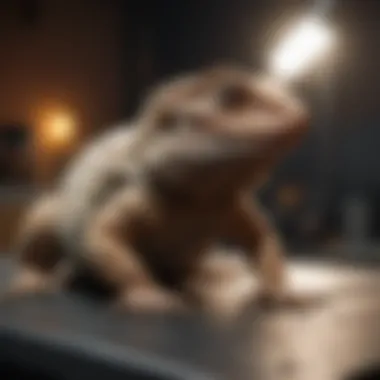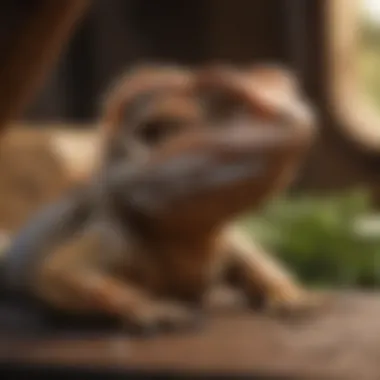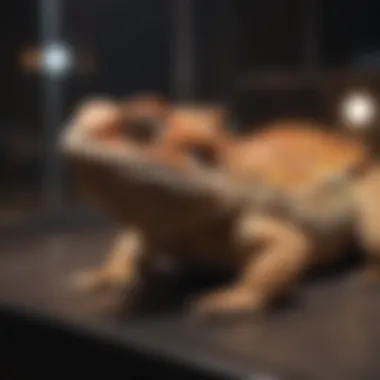Travel Tanks for Bearded Dragons: Key Considerations


Intro
Traveling with a bearded dragon requires careful planning to ensure their safety and comfort. Choosing the right travel tank is an essential task that significantly impacts their well-being. Bearded dragons are sensitive creatures, and their environments must be meticulously managed, especially during transport.
This article outlines practical considerations for selecting travel tanks tailored to the unique needs of bearded dragons. Important facets include size, ventilation, and the materials used in constructing these travel tanks. Understanding these factors can mitigate stress and promote a smoother travel experience for you and your pet.
Engaging in thoughtful preparations enhances not only the safety of your dragon but also fosters a healthier approach to travel and reptile care. Let us delve into the specifications of what makes a well-suited travel tank.
Essential Considerations for Travel Tanks
As mentioned, multiple factors influence the decision-making process for selecting a travel tank. Crucially, reptile owners need to focus on several specific characteristics that ensure comfort and safety during transportation.
Size of the Travel Tank
The tank's size should neither be too large nor too small. An ideal travel tank for bearded dragons must provide enough space for movement without posing a risk of injury. The dimensions should allow your bearded dragon to turn and shift positions. There should be firm guidelines to follow:
- Minimum Size: Typically, a travel tank should be around 20 gallons in volume for an adult bearded dragon.
- Dimensions: Ensure the length exceeds twice the dragon's length to provide sufficient space.
Choosing an appropriate size prevents undue stress and promotes calm behavior.
Ventilation Needs
Proper ventilation is one core aspect that cannot be overlooked. Bearded dragons benefit from stable airflow to regulate their temperature. A travel tank that is well-ventilated prevents overheating and promotes a comfortable environment.
Remember that good ventilation minimizes the risk of stress and balances humidity, which is essential for maintaining their health during travel.
Here are some tips regarding ventilation:
- Lid Design: Look for tanks with mesh tops or adequate holes on the sides.
- Double Check: Always ensure that the ventilation can withstand jarring movements while in transport.
Environmental Conditions
Simulating your dragon’s native habitat enhances their travel experience. Maintaining moderate temperatures within the tank will thus require heating elements suited for travel purposes. Controlled temperatures should reflect their usual requirements to prevent any health concerns.
Another aspect of environmental needs addresses the substrate used in the travel tank. Suitable substrates assist in keeping your dragon safe and comfortable:
- Paper Towel: Recommended for easy cleaning and comfort.
- Sand: Limit amount, as too much sand can lead to digestion problems if eaten.
Implementing these strategies aids in establishing a familiar atmosphere within the travel tank.
Material Considerations
When saaying nature and environments below, focus on safe materials that can withstand inevitable movements and abrupt stops you might encounter during travel:
- Acrylic or Polycarbonate tanks offer resistance to damage and lightweight passage.
- Avoid glass as it can shatter easily.
Consider using padded products or tank covers for transport.
Safety and Security Features
Believing in optimal protection for your dragon necessitates focusing on safety features included in your travel tank:
- Secure Lids: They should be properly lodged to prevent escape risk.
- Secure Development: Purchase from reputable manufacturers for assurance of quality.
Choosing a travel tank includes focused examination of multiple factors impacting the decision of reptile transportation. By adhering to the pointers above, owners can promote the health, comfort, and well-being of their bearded dragons during transit.
Understanding Bearded Dragons and Travel Needs


Traveling with bearded dragons requires careful consideration. Understanding their needs plays a crucial role in ensuring adequate care when they are in motion. This section elaborates on these aspects, shedding light on their natural behaviors and what they require for a safe trip.
Natural Habitat and Behavior
Bearded dragons, native to Australia, thrive in arid deserts, so their habitat is quite different from a typical indoor setting. This reptile enjoys basking in the sunlight while often retreating to cooler, shaded areas. Recognizing this behavior can help owners recreate an environment that keeps their pets comfortable during travel.
One major facet of their natural behavior is that they are quite tolerant of their surroundings when they feel secure. In the wild, bearded dragons decide where to move based on temperature, available food, and safety from predators. When introducing your bearded dragon into a travel tank, you need to mimic these elements. The ideal travel conditions should consider:
- Temperature stability: Creating a temperature gradient is vital. Ensure cooler and warmer areas within the tank.
- Hiding spots: Integrate elements like hides or tunnels so your dragon doesn't feel exposed.
- Minimal noise and movement: Quick or jerky motions can startle your pet and should be minimized.
Adapting these behaviors into transport rituals will decrease stress for your bearded dragon, ultimately helping them feel more secure.
Traveling with Bearded Dragons: The Essentials
When preparing for a trip with your bearded dragon, several essentials must be accounted for to guarantee a safe journey. Travel tanks should ideally be designed thoughtfully in order to accommodate the waya dragons move and feel safe. Here are key points to consider:
- Choosing the Right Tank: Ensure the travel tank replicates some aspects of their habitat, providing both security and comfort.
- Temperature Management: Maintaining temperature control is essential. Use heat packs if necessary but ensure they are secure and not overly hot.
- Water Access: Our dragons’ needs during travel also include hydrated environments. Use a small, spill-proof water container that is easily accessible.
- Feeding Considerations: Plan feeding time carefully, It may be best to feed before travel instead of during the trip.
Sharing the travel experience must prioritize ensuring stress-free conditions for our scaly companions. Each journey undertaken should blend these essentials to create a more hospitable transit.
In summary, travel for bearded dragons does not need to be daunting. Understanding their behavior and natural habitat informs a thoughtful approach to travel tank selection and journey planning.
Importance of a Suitable Travel Tank
Selecting an appropriate travel tank for a bearded dragon is non-negotiable. The travel tank acts as the temporary habitat for your pet during trips, ensuring its safety and comfort. A travel tank that fits best can significantly ease any discomfort caused by movement or an unfamiliar environment.
Furthermore, each dragon has distinct needs based on its size, age, and health. Providing an ideal setting during travel can greatly reduce stress and potential health issues. Addressing temperature control, ventilation, and adequate space in a tank helps guarantee that your bearded dragon remains in optimal condition on the road.
Defining the Purpose of a Travel Tank
A travel tank serves several important purposes. To begin with, it is crucial for transporting your pet safely, but it must also create an environment that mimics its natural habitat, albeit temporarily. This ensures comfort while aiding in mitigating stress, making any journey more manageable for your bearded dragon.
Considering whether going by car or air travel can also affect tank purpose. While vehicular travel often allows for larger units with greater amenities, air travel may require smaller, more portable solutions.
Here are some aspects that define the usability of a travel tank:
- Safety: Keeping the bearded dragon secure is paramount. Depending on the size and design, different tanks can better restrain movement during sudden stops or turbulence.
- Comfort: A well-designed travel tank with appropriate substrates and space ensures that the dragon does not feel confined or limited.
- Ventilation: Adequate airflow helps prevent overheating, especially during warm weather when the temperature in a vehicle can spike ominously.
Safety Considerations During Travel
Safety should always be prioritized when transporting a bearded dragon. Firstly, you need a well-constructed tank that prevents any chance of escape. This might mean looking for features like tight-fitting lids with secure closures. Additionally, checks need to happen before travel
- Evacuation plan: Know where to stop if situations demand attendance to your bearded dragon.
- Monitoring: Always keep an eye and make it possible for direct checks on the health and comportment aspects of the dragon as the journey progresses.
Proper handling involves being familiar with the peculiarities of your pet. Be aware that sudden loud noises or unexpected movements could unsettle the animal, making for a potentially negative experience. By adopting gradual exposure to the travel tank before embarking on it long journeys, one can help the dragon acclimatize appropriately.
“An appropriate travel tank is not merely a container; it is a lifeline for proper care and understanding of your reptilian companion.”
Adequate cooling packs or water jars should accompany them, alongside hydration checks to mitigate risks particularly when faced with greater travel times and intentional loads of warmth.
Key Features of a Travel Tank
When considering travel tanks for bearded dragons, it is crucial to focus on the unique features that can significantly affect the journey for these reptiles. Bearded dragons can have distinct preferences and needs, making it imperative that the travel tank is suited specifically for them. Understanding these essential features ensures the safety, comfort, and well-being of pet reptiles during transport.
Size Matters: Dimensions of the Tank
The dimensions of the travel tank directly impact your bearded dragon's comfort. An adequately sized tank prevents stress as it provides enough room for movement and repositioning. Ideally, the tank should be spacious enough to accommodate the dragon's length while also allowing for the placement of essential items like a heat source or hides. The height and width are also important; they should ensure no risk of your pet being crushed while still being easy to manage during transit.
Consider your bearded dragon's adult size when choosing. For juvenile designs that may quickly outgrow their initial transport options, a more suitable solution is a more spacious tank that allows for growth. Traveling in a space too small will alter behavior negatively and elevate stress levels.
Ventilation and Airflow Needs
Ventilation plays a vital role in maintaining a safe environment within a travel tank. Bearded dragons are ectothermic and rely on external heat sources, which means it is crucial for airflow to avoid overheating. Insufficient ventilation can result in fluctuating temperatures, risking the health of your reptile. It's necessary to balance the need for proper airflow with security to minimize risk of escape.


Choose tanks with mesh or small vent holes at sides to allow for continuous air circulation without compromising stability. Look also for tanks that can be closed tightly to deter escape but still communicate with the advantages of fresh air.
Material Choices: Plastic vs.
Glass
The choice for tank material will influence durability, insulation, and weight during transport. On one hand, plastic tanks are lightweight and can be easily lifted and moved when necessary. However, factors such as durability and temperature insulation need consideration.
Glass travel tanks, on the other hand, offer excellent visibility and easy cleaning but tend to be heavier and chippable. It's advantageus to select a material that can ensure both safety on the actual journey and hygiene after its use, while also being convenient to handle.
Points to consider when choosing material:
- Weight: Your ability to transport it easily.
- Durability: Ensuring longevity during frequent travels.
- Hygiene: Ease of maintenance before and after use.
Ease of Cleaning: Maintenance Considerations
Cleaning a travel tank is a non-negotiable task for any responsible pet owner. Built-up waste can pose great health risks, both to the pet itself and to future excursions. Thus, it’s important to choose a tank that is easy to disassemble or one that has smooth surfaces for cleaning.
Look for tanks with removable bases or designs that facilitate quick tidy-up. Being proactive in care and cleanliness ensures the reptile remains in good health, especially after travel.
In summary, when selecting a travel tank for your bearded dragon, pay keen attention to all dimensions and features described. The considerations laid out here are more than just details; they are decisive factors that can contribute to a positive transport experience for your cherished pet.
Setting Up the Travel Tank
Setting up the travel tank for a bearded dragon is a critical step that directly influences its comfort and well-being during transport. The process involves consideration of various factors important for the health and safety of the reptile. A well-equipped travel setting not only mitigates stress but also protects your pet from the hazards of mobile environments.
Having a suitable system aboard my travel tank reduces anxiety and ensures that the bearded dragon, under my care, remains secure in unfamiliar environments. Understanding both physical needs and behavioral considerations aids in assembling a setting that meets the specific requirements of these reptiles. Therefore, proper setup is not mere convenience; it is a necessary foundation for engaging with pets while adhering to best practices of reptile care.
Creating a Comfortable Environment
A comfortable environment is paramount for any travel scenario. In the case of bearded dragons, achieving this requires specific inclusions to mimic their natural habitat as closely as possible. It is beneficial to include hiding spaces to fabricate a sense of safety for your reptile. Log hides, small boxes, or even soft cloth mesh are practical options that allow your dragon to retreat when necessary.
The tank should maintain appropriate warmth. Bearded dragons thrive in warmer climates, hence keeping a heat source such as heating pads or heat bulbs can be essential. However, using thermometers in the travel tank will ensure the environment does not exceed safe limits during travel.
Another aspect of comfort is minimizing abrupt light changes. Bearded dragons may struggle with rapid shifts from dark to light. Using a covered area within the tank can help mitigate this sensitivity. As brief as the journey may be, during it the dragons may feel more relaxed if the environment is consistent with their usual space.
Setting up a travel tank effectively requires forethought into what makes your bearded dragon thrive and feel secure.
Using Substrates: What Works Best?
Choosing the right substrate is not only about aesthetics; it serves a functional purpose in way of habitat compatibility. Common choices of substrates include paper towels, reptile carpet, and sand. Each of these has distinct benefits and drawbacks.
- Paper Towels: This option is absorbent and easy to clean. It does entail the hassle of sifting through clean versus dirty materials, though care must take this convenience into consideration while packing.
- Reptile Carpet: While less absorbent than paper towels, this option allows for traction and a familiar texture for your bearded dragon. Cleaning involves more effort, as you may require routine washing.
- Sand: This offers a more natural aesthetic. Yet it can potentially lead to impaction issues if your bearded dragon ingests it. Thus, sand might benefit hybrid forms of setup or a means to occasionally change the texture.
Overall, attaining synthesized microhabitats within the travel tank serves to ease stress. Factors regarding specific needs during travel dictate substantial reactions based on their habitat expectations.
Traveling with Bearded Dragons: Best Practices
Traveling with bearded dragons requires considerable thought and attention to detail. Understanding best practices is vital to ensure the health and comfort of your pet lizard during journeys. Knowledge in this area can lead to more successful trips both for pets and their owners. This section will address aspects that can contribute to a safe transport experience for your bearded dragon.
Temperature Control During Transport
Temperature control plays a key role during the transport of your bearded dragon. These reptiles are ectothermic, meaning they rely on external heat sources to regulate their body temperature. If the environment is too cold or too hot, stress can occur, leading to health issues.
Here are some important tips:
- Check the Weather: Always be aware of the weather conditions before embarking on the trip. Alternating outdoor temperatures can create unwelcoming conditions for your bearded dragon.
- Use a Thermometer: Incorporate a thermometer to monitor the temperature inside the tank. A temperature range between 75°F and 85°F is typically suitable during travel.
- Heat Packs: Utilize heat packs during colder months. Ensure these are securely placed away from your pet to avoid burns.
- Avoid Sunlight: If traveling in a car, avoid direct sunlight on the tank. This can create hotspots, which may overheat your animal. Use sunshades or curtains to minimize the impact of sunlight.


Effective temperature management is crucial for a smooth travel experience with your bearded dragon.
Limiting Stress: Handling and Placement
Stress reduction is essential for the health of bearded dragons during transit. Bad experiences can lead to prolonged stress reactions in reptiles. Here are tips for handling and placement:
- Minimize Handling: While it might be tempting to take your beardie out for interaction, this could heighten stress levels. If possible, limit handling during the travel period.
- Stable Placement: Ensure the tank is on a stable surface. Sudden movements or vibrations could disturb the reptile, leading to anxiety.
- Cover the Tank: A blanket or cover can help make the environment feel secure to your bearded dragon. This reduces anxiety from visual stimuli during travel.
Understanding these key handling principles can create a more pleasant journey for your bearded dragon.
Hydration and Feeding Needs on the Go
Keeping your bearded dragon hydrated and addressing feeding requirements during travel is crucial for their well-being.
- Pre-Travel Hydration: Before heading out, make sure your dragon is hydrated. Offer food items, like greens or insects, with high moisture content.
- Avoid Feeding During Transport: It is advisable not to feed your beardie during the journey to prevent vomitting or digestive issues. If the trip exceeds a day, equity hydration solutions can be helpful.
- Water Bottle: Equip the travel tank with a simple water bottle. Monitoring water intake can be advantageous to ensure your bearded dragon stays hydrated.
Challenges of Traveling with Bearded Dragons
Traveling with bearded dragons presents unique challenges that require careful planning and attention. Understanding these difficulties is essential to ensure that both the reptile and the owner have a safe and comfortable experience. When undertaking trips with bearded dragons, several crucial elements come into play, such as motion sickness, environment fluctuations, and sudden emergencies.
Dealing with Motion Sickness
Motion sickness can be a noteworthy concern when traveling. Bearded dragons are sensitive creatures, and changes in their environment may trigger stress. Sometimes, this stress manifests as symptoms of motion sickness, similar to what humans experience. Signs may include lethargy, excessive salivation, or even vomiting. It is vital to recognize these symptoms promptly.
Several strategies can mitigate the likelihood of motion sickness:
- Maintain Stability: Ensure the travel tank is secure, avoiding any jerky movements. A stable environment can help reduce the feeling of disorientation for the bearded dragon.
- Gradual Acclimatization: Before significant travels, acclimate them to shorter trips. This exposure helps them adapt positively.
- Temperature Regulation: Be aware that a sudden change in temperature can add to stress, so keep the conditions steady.
Using these approaches may minimize discomfort and allow for a more enjoyable journey.
Unexpected Situations and How to Prepare
No matter how well-prepared one is, unexpected situations during travels can arise. These include delays, unexpected weather changes, or needs for emergency stops. Preparing for the unforeseen impacts more than just having a fully stocked travel tank; it's about anticipating challenges.
Here are important preparations to consider:
- Emergency Kit: Carry a kit that includes hydration solutions, food that can be easily consumed on the go, and basic medical supplies to handle potential health issues.
- Adaptability: Create a backup plan for unexpected situations. Knowing nearby veterinarians or pet shops can be beneficial.
- Familiar Items: Bringing along familiar blankets or toys can help ease anxiety in case of prolonged travel situations.
Being equipped with knowledge and resources to handle these challenges can transform a potentially stressful experience into manageable one. By understanding and preparing for common traveling difficulties, owners can fortify their bearded dragons’ travel experience.
The key to successful travel with bearded dragons lies in thoughtful preparation, mitigation of stress factors, and complacency with unpredictable events.
Ending: Making Informed Choices for Your Bearded Dragon
Traveling with bearded dragons can be a complex process that requires careful planning and understanding. Choosing the right travel tank is not merely about aesthetics. It encompasses various important factors that contribute to the wellbeing and safety of your reptile. Decisions you make directly influence your pet's comfort, accessibility to air, and overall health during transport.
The Importance of Responsible Pet Ownership
Owning a bearded dragon comes with significant responsibilities, particularly when it involves travel. As a responsible pet owner, it is critical to consider how each travel scenario may affect your dragon's physical and emotional state. This requires awareness of not just the basic creature comforts, but also a thorough understanding of their behavioral and environmental needs.
A well-informed pet owner prioritizes the animal's needs over convenience.
When selecting a travel tank, consider factors such as size, ventilation, and material. Your choices can minimize anxiety and stress for the animal, ensuring that the journey is as smooth as possible. Ignoring these important elements can lead to detrimental effects on your bearded dragon. An informed choice empowers you not just as a caretaker, but as an advocate for your pet's health.
Final Thoughts on Travel Tanks for Bearded Dragons
In summation, the topic of travel tanks for bearded dragons is not to be overlooked. Equip yourself with comprehensive knowledge about what constitutes a viable travel solution: impose your understanding of size, material preferences, and health-safety considerations into your selection process.
Different situations may arise. Whether you are embarking on a short trip or a prolonged journey, the tank functions as your dragon's temporary habitat. Prioritize its comfort, and your pet will reflect that restraint in its behavior.
Ultimately, understanding all aspects of transporting a bearded dragon can lead to enriching experiences for both the animal and the owner. Taking the time to analyze, reason, and implement thoughtful choices will serve the dual purpose of keeping your beloved reptile safe and enhancing your relationship.
No matter how challenging it seems, meke sure you oaddress every concern during travel. Doing so will rozwolutionize how you view travel as a dimension of pet ownership.













